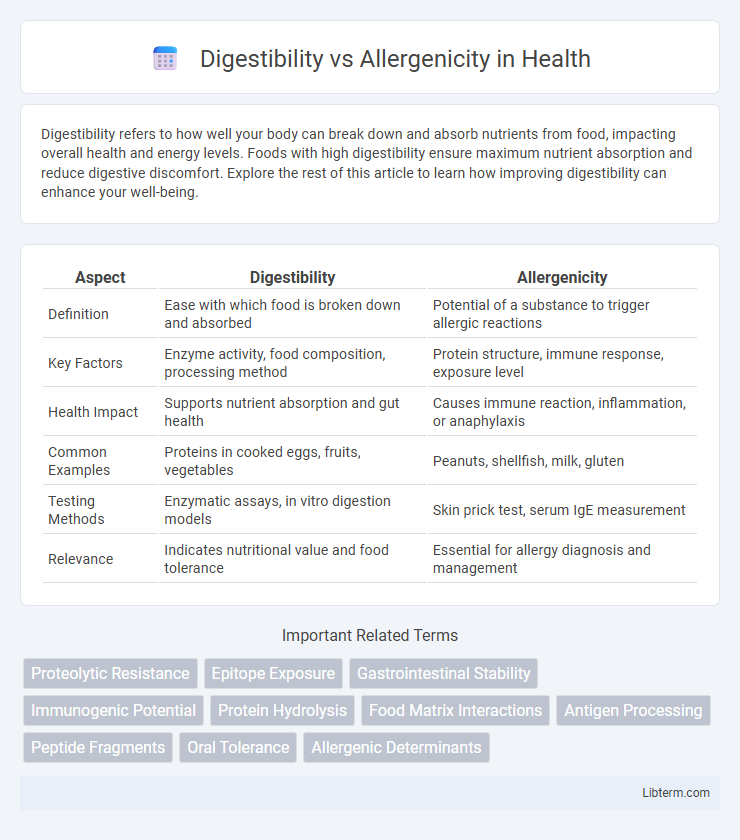Digestibility refers to how well your body can break down and absorb nutrients from food, impacting overall health and energy levels. Foods with high digestibility ensure maximum nutrient absorption and reduce digestive discomfort. Explore the rest of this article to learn how improving digestibility can enhance your well-being.
Table of Comparison
| Aspect | Digestibility | Allergenicity |
|---|---|---|
| Definition | Ease with which food is broken down and absorbed | Potential of a substance to trigger allergic reactions |
| Key Factors | Enzyme activity, food composition, processing method | Protein structure, immune response, exposure level |
| Health Impact | Supports nutrient absorption and gut health | Causes immune reaction, inflammation, or anaphylaxis |
| Common Examples | Proteins in cooked eggs, fruits, vegetables | Peanuts, shellfish, milk, gluten |
| Testing Methods | Enzymatic assays, in vitro digestion models | Skin prick test, serum IgE measurement |
| Relevance | Indicates nutritional value and food tolerance | Essential for allergy diagnosis and management |
Understanding Digestibility: Definition and Importance
Digestibility refers to the efficiency with which food or nutrients are broken down and absorbed by the digestive system, directly impacting nutrient availability and overall health. It plays a crucial role in assessing food quality, particularly in distinguishing between allergenic and non-allergenic proteins, as poorly digestible proteins are more likely to trigger immune responses. Understanding digestibility helps in developing hypoallergenic food products and improving dietary recommendations for individuals with food sensitivities.
What is Allergenicity? Core Concepts
Allergenicity refers to the potential of a substance, typically proteins, to trigger an immune response leading to allergic reactions. Core concepts include the recognition of specific epitopes by IgE antibodies, the stability of allergens during digestion, and their ability to cross the gut barrier to activate immune cells. Understanding allergenicity is crucial for assessing food safety and managing allergic diseases.
The Science Behind Food Digestibility
The science behind food digestibility explores how efficiently the human digestive system breaks down nutrients into absorbable forms, impacting nutrient availability and overall health. Digestibility varies based on food matrix complexity, enzymatic activity, and individual physiological factors, influencing the bioaccessibility of proteins, carbohydrates, and fats. Understanding these mechanisms helps differentiate between digestible proteins and allergenic proteins that resist digestion, potentially triggering immune responses in susceptible individuals.
Factors Influencing Allergenicity in Foods
Factors influencing allergenicity in foods include protein structure, enzymatic stability, and processing methods that alter molecular properties. Digestibility impacts allergenicity by affecting protein breakdown; resistant proteins tend to survive digestion and elicit immune responses. Genetic modifications and food matrix interactions further modify allergenic potential by influencing protein exposure and immune recognition.
Digestibility vs Allergenicity: Key Differences
Digestibility measures how efficiently the digestive system breaks down food into absorbable nutrients, while allergenicity refers to the potential of a substance to trigger an immune response causing allergic reactions. Foods with high digestibility often have proteins that are more easily degraded, reducing their allergenic potential by limiting exposure to intact allergenic proteins. Understanding these key differences informs the development of hypoallergenic diets and improves the management of food allergies by focusing on protein structure and digestion dynamics.
How Digestibility Affects Allergenic Response
Digestibility influences allergenic response by determining how proteins are broken down in the digestive system, affecting the immune system's exposure to intact allergens. Proteins resistant to digestion tend to reach the intestinal mucosa in larger fragments, increasing the likelihood of triggering an immune response and allergic sensitization. Enhanced enzymatic degradation of allergenic proteins often reduces their ability to elicit IgE-mediated hypersensitivity reactions.
Common Foods: High Digestibility, Low Allergenicity
Common foods such as rice, apples, and carrots exhibit high digestibility, facilitating efficient nutrient absorption and minimal gastrointestinal discomfort. These foods are associated with low allergenicity due to their simple protein structures and reduced potential to trigger immune responses. Incorporating such ingredients supports balanced nutrition while minimizing the risk of allergic reactions in sensitive individuals.
Managing Food Choices: Reducing Allergenicity Risks
Managing food choices to reduce allergenicity risks involves selecting foods with higher digestibility, as easier digestion minimizes the immune system's exposure to intact proteins that trigger allergies. Emphasizing foods processed through methods such as fermentation, hydrolyzation, or thorough cooking can significantly lower allergenicity by breaking down complex proteins into simpler peptides. Prioritizing highly digestible ingredients supports safer diets for individuals with food sensitivities, reducing the likelihood of allergic reactions.
Innovations in Food Processing: Enhancing Digestibility
Innovations in food processing improve digestibility by breaking down complex proteins and fibers, facilitating easier nutrient absorption. Techniques such as enzymatic hydrolysis, fermentation, and high-pressure processing reduce allergenic potential by altering protein structures, minimizing immune system activation. These advanced methods contribute to producing hypoallergenic food products with enhanced bioavailability and nutritional value.
Future Perspectives: Balancing Nutrition and Allergen Safety
Future perspectives in food science emphasize enhancing protein digestibility while minimizing allergenicity through advanced biotechnological approaches such as gene editing and enzyme treatment. Innovations in predictive computational models enable precise assessment of allergenic potential, allowing tailored modification of food proteins to maintain nutritional value without triggering immune responses. Integration of personalized nutrition and immunotherapy could further balance dietary benefits and allergen safety, paving the way for safer, highly digestible food products.
Digestibility Infographic

 libterm.com
libterm.com